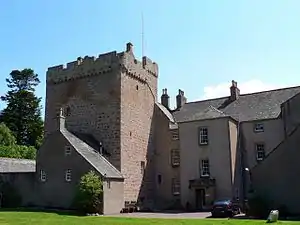Kilravock Castle
Kilravock Castle (pronounced Kilrawk[1]) is located near the village of Croy, between Inverness and Nairn, in the council area of Highland, Scotland.[2] It was begun around 1460 and has been the seat of the Clan Rose since that time. The castle is a composite of a 15th-century tower house and several later additions.[3] The original name for the castle was Cill Rathaig; Scottish Gaelic meaning "church at the small circular fort".

History
The lands were owned by the Boscoe family and it passed via marriage of Andrew Boscoe to his wife Elizabeth Bissett of the Bissett family in the 12th century, after Bosco's death his widow then deposed the lands via marriage of their daughter Mary Boscoe to Hugh II de Ros of the Rose family in the 13th century.[4]
Its keep dates from around 1460, when the then Baron of Kilravock was granted a licence to build by the Lord of the Isles.[5] This was extended in the 17th century, with the addition of a square stair tower, and the south range. The north and west sides of the quadrangle were added later.[6] Mary, Queen of Scots, was received at the castle in 1562, and Prince Charles Edward Stuart was entertained four days before the battle of Culloden. His enemy, the Duke of Cumberland, visited soon after the battle, and Robert Burns came here in September 1787.[5] It is a Category A listed building, and is no longer occupied by the Rose Clan.[7] The Castle is no longer part of the Rose Clan estate, in 1984 the Castle was transferred to a charitable Christian Trust.[7] It was operated as bed and breakfast accommodation for a while, but is no longer open to the public.[7]
The Rose family
Kilravock Castle has been continuously tenanted by the Roses, a family of Norman origin, who arrived in Britain with William the Conqueror. They settled at Kilravock in 1293, since which date son has succeeded father without the interposition of a collateral heir, an instance of direct descent unique in Scottish history.[8]
Moreover, many Roses have borne the Christian name of Hugh, and only one attained to a higher social rank than that of laird. The Chief of the Clan Rose, Anna Elizabeth Emily Guillemard Rose, 25th of Kilravock died peacefully, at Nairn on 9 December 2012, aged 88 years.[9] The Lord Lyon recognized David Hugh Heriot Baird Rose, the nephew of Elizabeth Rose as Chief of Clan Rose and the 26th Baron of Kilravock in June 2013.
Notes
- Citations
- "Kilravock Castle History". Kilravock Castle. Retrieved 2008-12-08.
- Ordnance Survey of Nairnshire. OS map to the County Series Maps, Scotland. http://maps.nls.uk/os/view/?sid=74400919#zoom=3&lat=6724&lon=9108&layers=BT
- "Full text of "The history of the Province of Moray : comprising the counties of Elgin and Nairn, the greater part of the County of Inverness and a portion of the County of Banff, all called the Province of Moray before there was a division into counties"". Archive.org. Retrieved 2013-07-27.
- Coventry, p.44.
- Historic Environment Scotland. "Kilravock Castle, Dovecote and Garden Walls (Category A Listed Building) (LB1841)". Retrieved 2019-03-27.
- Historic Environment Scotland. "Kilravock Castle, NMRS Number: NH84NW 2.00 (15032)". Canmore. Retrieved 2008-12-08.
- "A Unique Scottish Castle". www.kilravock.com. Retrieved 2016-03-07.
- A genealogical deduction of the family of Rose of Kilravock. by Rev. Hugh Rose, Minister of Nairne. 1748. https://archive.org/stream/genealogicaldedu00spal#page/n9/mode/2up
- William, Michael. "ROSE Anna Elizabeth : Obituary - Announcements - Scotsman - Scotland". Announce.jpress.co.uk. Archived from the original on 2013-04-21. Retrieved 2013-07-27.
References
- Coventry, Martin (2010). Castles of the Clans; The Strongholds and Seats of 750 Scottish Families and Clans (Reprint ed.). Musselburgh, Scotland: Goblinshead. ISBN 1-899874-36-4.
| Wikimedia Commons has media related to Kilravock Castle. |
